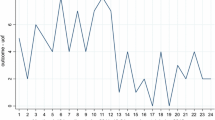Abstract
This paper explores differences between the stated purpose and actual practice of electronically monitored home confinement as a prison-diversion strategy. Methods and data are triangulated to examine the difference between the stated purposes of electronic monitoring and its actual usage in two contexts: 1) the decision to imprison/probate; and 2) the actual use of electronically monitored home confinement. Sentencing information, along with data on employment, family, substance abuse, prior convictions, and type of offense, were collected on 391 felony offenders sentenced to probation in 1987–89 from three counties located in two large Metropolitan Statistical Areas in Texas. Information gathered from interviews with probation officials is also employed. This paper presents an analysis of this data and discusses its implications for future use and evaluation of electronically monitored home confinement.
Similar content being viewed by others
References
Austin, J. and B. Krisberg (1982) The Unmet Promise of Alternatives to Incarceration. Crime and Delinquency28(3): 374–409.
Ball, R. and J. Lilly (1986a) The Potential Use of Home Incarceration for Drunken Drivers. Crime & Delinquency32 (2): 20–35.
— (1986b) A Theoretical Examination of Home Incarceration. Federal ProbationL(1): 17–24.
Ball, R., C. Huff, and R. Lilly (1988) House Arrest and Correctional Policy: Doing Time at Home. Newbury Park, CA: Sage Publications, Inc.
Becker, H. (1963) Outsiders: Studies in the Sociology of Deviance. New York, NY: Free Press.
Clear, T. and C. Shapiro (1986) Identifying High Risk Probationers for Supervision in the Community: The Oregon Model. Federal ProbationL(2): 42–49.
Cole, G. (1983) The American System of Criminal Justice. Monterey, CA: Brooks/Cole Publishing Company.
Denzin, N. (1989) The Research Act: A Theoretical Introduction to Sociological Methods. Englewood Cliffs, NJ: Prentice Hall.
Feeley, M. (1983) Court Reform on Trial. New York, NY: Basic Books.
Flynn, L. (1986) House Arrest: Florida’s Alternative Eases Crowding and Tight Budgets. Corrections Today48(5): 64–68.
Friel, C. and J. Vaughn (1986) A Consumer’s Guide to the Electronic Surveillance of Probationers. Federal ProbationL(3): 3–14.
Granoff, A. (1988)My Word. Dallas Times Herald March 28.
Grinter, R. C. (1989) Electronic Monitoring of Serious Offenders in Texas. Journal of Offender Monitoring.2(4): 1–14.
Hofer, P. and B. Meierhoefer (1987) Home Confinement: An Evolving Sanction In The Federal Criminal Justice System. Washington, D.C.: Federal Judicial Center.
Kuhn, M. (1962) The Interview and the Professional Relationship in A. Rose (ed.), Human Behavior and Social Process. Boston, MA: Houghton Mifflin.
Lindesmith, A. (1947) Opiate Addiction. Bloomington, IN: Principia Press.
Lilly, J. R. and R. A. Ball (1987) A Brief History of House Arrest and Electronic Monitoring. Northern Kentucky Law Review.13(3): 343–374.
Lilly, J., R. Ball and J. Wright (1987) Home Incarceration with Electronic Monitoring in Kenton County, Kentucky: An Evaluation in B. McCarthy (ed.), Intermediate Punishments: Intensive Supervision. Home confinement and Electronic Surveillance. Monsey, NY: Willow Tree Press, Inc.
Meachum, L. (1986) House Arrest The Oklahoma Experience. Corrections Today48(6): 102–108.
Palm Beach County, Florida Sheriff’s Department (1987) Palm Beach County’s In-House Arrest Work Release Program, in B. McCarthy (ed.), Intermediate Punishments: Intensive Supervision. Home Confinement and Electronic Surveillance. Monsey, NY: Willow Tree Press, Inc.
Pearson, F. and D. Bibel (1986) New Jersey’s Intensive Supervision Program: What Is It Like? How Is It Working? Federal ProbationL(2): 25–31.
Petersilia, J. (1987) Expanding Options for Criminal Sentencing. Santa Monica, CA: Rand Corporation.
Renzema, M. (1989) Monitoring in the United States: 1989. Paper presented at theThird International Conference on the Electronic Monitoring of Offenders. Leicester, England.
-(1990) Personal communication. 2 May.
Sandhu, H. S. (1981) Community Corrections: New Horizons. Springfield, IL: Charles C. Thomas.
Schwitzgebel, R. (1969) Issues in the Use of an Electronic Rehabilitation System with Chronic Recidivists. Law and Society ReviewIII(4): S97–611.
Schwitzgebel, R., W. Pahnke and W. Hurd (1964) A Program of Research in Behavior Electronics. Behavioral Science9: 233–238.
Schmidt, A. (1987) The Use Of Electronic Monitoring By Criminal Justice Agencies (Discussion paper). Washington, D.C.: National Institute of Justice.
Schmidt, A. and C. Curtis (1987) Electronic Monitors in B. McCarthy (ed.), Intermediate Punishments: Intensive Supervision. Home Confinement and Electronic Surveillance. Monsey, NY: Willow Tree Press, Inc.
Texas Criminal Procedure-Code and Rules (1988). St. Paul, MN: West Publishing Company.
Vaughn, J. (1987) Planning for Change: The Use of Electronic Monitoring as a Correctional Alternative in B. McCarthy (ed.), Intermediate Punishments: Intensive Supervision. Home Confinement and Electronic Surveillance. Monsey, NY: Willow Tree Press, Inc.
Author information
Authors and Affiliations
Rights and permissions
About this article
Cite this article
Quinn, J.F., Holman, J.E. “Purpose versus practice in the use of electronically monitored home confinement”. AJCJ 15, 157–171 (1990). https://doi.org/10.1007/BF02887462
Issue Date:
DOI: https://doi.org/10.1007/BF02887462



